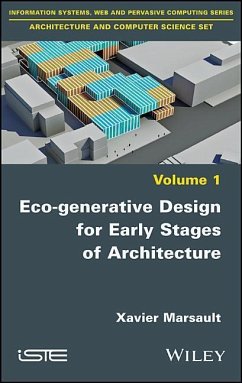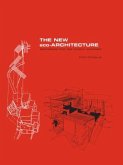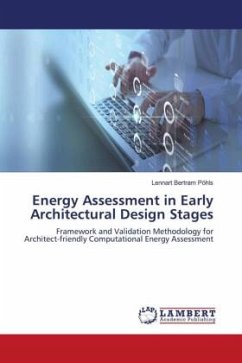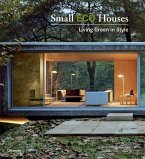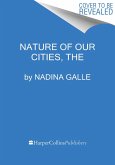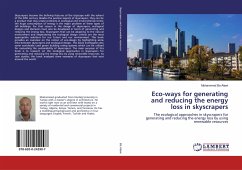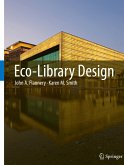Xavier Marsault
Eco-Generative Design for Early Stages of Architecture
Xavier Marsault
Eco-Generative Design for Early Stages of Architecture
- Gebundenes Buch
- Merkliste
- Auf die Merkliste
- Bewerten Bewerten
- Teilen
- Produkt teilen
- Produkterinnerung
- Produkterinnerung
This book can be first considered as a complete synthesis of the EcCoGen ANR project (2011-2012), involving researchers from different French labs (including MAP) and domains, breaking major difficulties of the real-time generative design in the early stages of a pre-architectural project. Then the scope becomes larger, and the authors introduce major prospects following recent advances on natural and artificial evolution.
Andere Kunden interessierten sich auch für
![The New Eco-Architecture The New Eco-Architecture]() Colin PorteousThe New Eco-Architecture229,99 €
Colin PorteousThe New Eco-Architecture229,99 €![Energy Assessment in Early Architectural Design Stages Energy Assessment in Early Architectural Design Stages]() Lennart Bertram PöhlsEnergy Assessment in Early Architectural Design Stages45,99 €
Lennart Bertram PöhlsEnergy Assessment in Early Architectural Design Stages45,99 €![Small Eco Houses Small Eco Houses]() Cristina Paredes BenitezSmall Eco Houses25,99 €
Cristina Paredes BenitezSmall Eco Houses25,99 €![The Nature of Our Cities The Nature of Our Cities]() Nadina GalleThe Nature of Our Cities20,99 €
Nadina GalleThe Nature of Our Cities20,99 €![Sustainable Sustainable]() Avi FriedmanSustainable35,99 €
Avi FriedmanSustainable35,99 €![Eco-ways for generating and reducing the energy loss in skyscrapers Eco-ways for generating and reducing the energy loss in skyscrapers]() Mohammed Ba AlawiEco-ways for generating and reducing the energy loss in skyscrapers54,99 €
Mohammed Ba AlawiEco-ways for generating and reducing the energy loss in skyscrapers54,99 €![Eco-Library Design Eco-Library Design]() John A. FlanneryEco-Library Design75,99 €
John A. FlanneryEco-Library Design75,99 €-
-
-
This book can be first considered as a complete synthesis of the EcCoGen ANR project (2011-2012), involving researchers from different French labs (including MAP) and domains, breaking major difficulties of the real-time generative design in the early stages of a pre-architectural project. Then the scope becomes larger, and the authors introduce major prospects following recent advances on natural and artificial evolution.
Produktdetails
- Produktdetails
- Verlag: Wiley
- Seitenzahl: 224
- Erscheinungstermin: 13. März 2018
- Englisch
- Abmessung: 236mm x 157mm x 18mm
- Gewicht: 476g
- ISBN-13: 9781786301802
- ISBN-10: 1786301806
- Artikelnr.: 50129687
- Herstellerkennzeichnung
- Libri GmbH
- Europaallee 1
- 36244 Bad Hersfeld
- gpsr@libri.de
- Verlag: Wiley
- Seitenzahl: 224
- Erscheinungstermin: 13. März 2018
- Englisch
- Abmessung: 236mm x 157mm x 18mm
- Gewicht: 476g
- ISBN-13: 9781786301802
- ISBN-10: 1786301806
- Artikelnr.: 50129687
- Herstellerkennzeichnung
- Libri GmbH
- Europaallee 1
- 36244 Bad Hersfeld
- gpsr@libri.de
Xavier Marsault, CNRS, France
Introduction xi
Chapter 1. Context 1
1.1. The environmental context 1
1.1.1. Ecology: an ancient concept 1
1.1.2. The Anthropocene and urban concentration 2
1.1.3. The increase in the Earth's temperature 3
1.1.4. Architecture and environmental thinking 3
1.2. The energy context 4
1.2.1. The energy crisis 4
1.2.2. Energy consumption in houses 5
1.2.3. Strong measures 6
1.2.4. "Smart city" versus energetic city 6
1.3. The technological context 7
1.4. The economic and social context 8
1.5. The professional context 9
1.5.1. The roles of the architect today 9
1.5.2. Architectural design and the numerous constraints 10
1.5.3. Issues that call into question the fields of development and the
living environment 11
1.6. The instrumental context 11
1.6.1. Transformational tools unsuited to the creative process 11
1.6.2. A lack of assessment tools from the sketching phase 12
1.6.3. The need for computer-based modeling 13
1.7. The programmatic context 14
1.7.1. Sketching and creativity phases 14
1.7.2. Support tools 15
1.8. The cognitive, ergonomic and sensory contexts 17
1.8.1. Psycho-cognitive issues 17
1.8.2. Human-machine interfaces (HMI) 18
1.8.3. Stimulating the creativity of architects in the sketching phase 18
1.8.4. The comfort approach 19
Chapter 2. Eco-design 21
2.1. Eco-design of the built environment 21
2.2. Eco-design: a continually developing process 22
2.2.1. Passive tool, labeling and reference documents 23
2.2.2. From HQE to HQE-Performance 24
2.2.3. "Passive building" label 25
2.2.4. BBCA label 25
2.2.5. Learning to think BEPOS (E+) and low carbon (C¿) 26
2.2.6. The PEBN reference document 28
2.2.7. Environmentally friendly building materials 29
2.3. Life-cycle analysis (LCA) 30
2.3.1. The benefits of LCA 30
2.3.2. Main LCA software programs 31
2.3.3. Associated databases 32
2.3.4. Difficulties relating to LCA and its use 34
2.4. Eco-design and BIM 36
2.5. Eco-design and efficient morphologies 36
2.5.1. Compactness indices of a structure 37
2.5.2. The influence of building height 38
2.5.3. Density, compactness, sprawl 39
2.6. Examples of software environments adapted to generative eco-design 41
2.6.1. Genomics 42
2.6.2. Building Synthesizer 42
2.6.3. ParagenTool: performance-oriented design of large passive solar
roofs 43
2.6.4. Eco.mod 43
2.6.5. VizCab 45
Chapter 3. Morphogenetics 49
3.1. Scientific formalisms of natural morphogenesis 49
3.1.1. Morphogenesis, growth and stability 49
3.1.2. Structure is law 50
3.1.3. Self-organization, Darwinism and structuralism 51
3.2. Generation of forms for architecture 52
3.2.1. Classic form modeling typology 52
3.2.2. Parametric architecture 53
3.2.3. Techno-organic architecture 54
3.2.4. An old debate 54
3.2.5. Generative architecture 55
3.2.6. Performative architecture 56
3.2.7. Eco-design and morphogenetics of energy 57
3.3. The specific case of the voxels approach 58
3.3.1. The evolving house 58
3.3.2. VOxEL 59
3.3.3. Other modular constructions 60
3.4. Optimization through genetic algorithms 62
3.4.1. Design and optimization 62
3.4.2. Algorithms and evolutionary environments 62
3.4.3. General plan of a genetic algorithm (GA) 63
3.4.4. Pareto front 65
3.4.5. Choice of fitnesses 66
3.4.6. Multi-genomic algorithms 67
3.5. Detailed presentation of a genetic algorithm 67
3.5.1. Jaszkiewicz's MOGLS 68
3.5.2. Directional optimization 69
3.5.3. Maintaining population diversity 70
3.5.4. ACROMUSE 70
3.5.5. Improvements and multi-objective extension 71
3.5.6. Use of GA as a constraint solver 72
3.6. Interactive evolutionary algorithms (IEA) 72
3.6.1. Possibilities and limitations 72
3.6.2. Multi-objective optimization combined with an IGA 74
3.6.3. A multi-objective IGA for efficient and diversified solutions 74
Chapter 4. Assessment Models and Meta-models 79
4.1. The concept of a model 79
4.2. Models and tools suited to the advanced phases of building design 80
4.2.1. Detailed modeling of the energy behavior of a building 81
4.2.2. Thermal regulations in France 82
4.2.3. Software environments for project simulation 82
4.3. Simplified modeling: difficulties and examples 85
4.3.1. Geometric scales 85
4.3.2. Processing speed 86
4.3.3. Simplified thermal modeling in winter or summer conditions 86
4.3.4. Solar gains received by the envelope of the buildings on a site 88
4.3.5. DaylightGen 89
4.4. Meta-modeling 89
4.4.1. Choosing a type of meta-model 90
4.4.2. Experimental designs 91
4.4.3. Sensitivity analysis 91
4.4.4. Study of three recent meta-models 92
4.5. Some prospects with major scientific obstacles 96
4.5.1. Aeraulic modeling for the upstream phase 96
4.5.2. Taking climate change into account in upstream design 99
Chapter 5. The EcoGen Software Program 105
5.1. Genesis of the project 106
5.1.1. EcoGen-N (MAP-Crai) 107
5.1.2. EcoGen-L (MAP-Aria) 109
5.2. General principles of EcoGen 109
5.2.1. An original proposal 109
5.2.2. A one-of-a-kind tool 110
5.3. A generative and modular tool 111
5.3.1. Operating methods 112
5.3.2. Modularity 113
5.4. Urban, morphological and programmatic contexts 114
5.4.1. Site and operational context 114
5.4.2. Morphological and functional description 115
5.4.3. Description of a program 116
5.5. Bioclimatic optimization of the generated solutions 117
5.5.1. The example of EcoGen1 117
5.5.2. Granularity of design 118
5.6. EcoGen2 assessment criteria 119
5.7. Interface and interactivity 123
5.7.1. Description of the interface 123
5.7.2. The command zone 127
5.7.3. Launching a new session 128
5.8. Assessment of "high-efficiency" solutions and calculations 128
5.9. Short-term prospects 131
5.9.1. Eco2Gen: a future prospect for project eco-design and economics 131
5.9.2. LCA in the sketching phase 131
5.9.3. Assessment of solar energy potential 132
5.9.4. Interactions 133
5.9.5. Prospects for moving beyond the voxel-based approach 133
5.9.6. Phylogenetic representations of design dynamics 134
5.10. Experiments, results, development 134
5.10.1. Results 134
5.10.2. Assessment of creativity in an evolutionary design environment 137
5.10.3. Morphological generation, efficiency and innovation 139
5.10.4. Potential targets, dissemination and training in professional
environments 140
Chapter 6. Bio-inspired Perspectives 143
6.1. Biomimicry issues in architecture 143
6.1.1. The genesis of bio-inspiration in architecture 144
6.1.2. Biomimetic architecture: towards a rebirth of form? 144
6.1.3. Methodologies and findings 146
6.1.4. Conclusion 149
6.2. A return to the theories of evolution 149
6.2.1. A brief history of natural evolution 149
6.2.2. What's new since Darwin? 151
6.3. New morphogenetic approaches 152
6.3.1. Urban forms and pleiotropy 152
6.3.2. Complexity and evolution of built environments 153
6.3.3. Evolutionary creativity 154
6.3.4. Structural or second-order evolution 155
6.3.5. A proposal for bio-inspired architectural genetics 156
6.4. Assisted creativity, coevolution and design of learning systems 158
6.4.1. Ergonomics and design of coevolutionary and learning systems 158
6.4.2. Computational resonance and artificial creativity 159
Conclusion 161
Bibliography 167
Index 187
Chapter 1. Context 1
1.1. The environmental context 1
1.1.1. Ecology: an ancient concept 1
1.1.2. The Anthropocene and urban concentration 2
1.1.3. The increase in the Earth's temperature 3
1.1.4. Architecture and environmental thinking 3
1.2. The energy context 4
1.2.1. The energy crisis 4
1.2.2. Energy consumption in houses 5
1.2.3. Strong measures 6
1.2.4. "Smart city" versus energetic city 6
1.3. The technological context 7
1.4. The economic and social context 8
1.5. The professional context 9
1.5.1. The roles of the architect today 9
1.5.2. Architectural design and the numerous constraints 10
1.5.3. Issues that call into question the fields of development and the
living environment 11
1.6. The instrumental context 11
1.6.1. Transformational tools unsuited to the creative process 11
1.6.2. A lack of assessment tools from the sketching phase 12
1.6.3. The need for computer-based modeling 13
1.7. The programmatic context 14
1.7.1. Sketching and creativity phases 14
1.7.2. Support tools 15
1.8. The cognitive, ergonomic and sensory contexts 17
1.8.1. Psycho-cognitive issues 17
1.8.2. Human-machine interfaces (HMI) 18
1.8.3. Stimulating the creativity of architects in the sketching phase 18
1.8.4. The comfort approach 19
Chapter 2. Eco-design 21
2.1. Eco-design of the built environment 21
2.2. Eco-design: a continually developing process 22
2.2.1. Passive tool, labeling and reference documents 23
2.2.2. From HQE to HQE-Performance 24
2.2.3. "Passive building" label 25
2.2.4. BBCA label 25
2.2.5. Learning to think BEPOS (E+) and low carbon (C¿) 26
2.2.6. The PEBN reference document 28
2.2.7. Environmentally friendly building materials 29
2.3. Life-cycle analysis (LCA) 30
2.3.1. The benefits of LCA 30
2.3.2. Main LCA software programs 31
2.3.3. Associated databases 32
2.3.4. Difficulties relating to LCA and its use 34
2.4. Eco-design and BIM 36
2.5. Eco-design and efficient morphologies 36
2.5.1. Compactness indices of a structure 37
2.5.2. The influence of building height 38
2.5.3. Density, compactness, sprawl 39
2.6. Examples of software environments adapted to generative eco-design 41
2.6.1. Genomics 42
2.6.2. Building Synthesizer 42
2.6.3. ParagenTool: performance-oriented design of large passive solar
roofs 43
2.6.4. Eco.mod 43
2.6.5. VizCab 45
Chapter 3. Morphogenetics 49
3.1. Scientific formalisms of natural morphogenesis 49
3.1.1. Morphogenesis, growth and stability 49
3.1.2. Structure is law 50
3.1.3. Self-organization, Darwinism and structuralism 51
3.2. Generation of forms for architecture 52
3.2.1. Classic form modeling typology 52
3.2.2. Parametric architecture 53
3.2.3. Techno-organic architecture 54
3.2.4. An old debate 54
3.2.5. Generative architecture 55
3.2.6. Performative architecture 56
3.2.7. Eco-design and morphogenetics of energy 57
3.3. The specific case of the voxels approach 58
3.3.1. The evolving house 58
3.3.2. VOxEL 59
3.3.3. Other modular constructions 60
3.4. Optimization through genetic algorithms 62
3.4.1. Design and optimization 62
3.4.2. Algorithms and evolutionary environments 62
3.4.3. General plan of a genetic algorithm (GA) 63
3.4.4. Pareto front 65
3.4.5. Choice of fitnesses 66
3.4.6. Multi-genomic algorithms 67
3.5. Detailed presentation of a genetic algorithm 67
3.5.1. Jaszkiewicz's MOGLS 68
3.5.2. Directional optimization 69
3.5.3. Maintaining population diversity 70
3.5.4. ACROMUSE 70
3.5.5. Improvements and multi-objective extension 71
3.5.6. Use of GA as a constraint solver 72
3.6. Interactive evolutionary algorithms (IEA) 72
3.6.1. Possibilities and limitations 72
3.6.2. Multi-objective optimization combined with an IGA 74
3.6.3. A multi-objective IGA for efficient and diversified solutions 74
Chapter 4. Assessment Models and Meta-models 79
4.1. The concept of a model 79
4.2. Models and tools suited to the advanced phases of building design 80
4.2.1. Detailed modeling of the energy behavior of a building 81
4.2.2. Thermal regulations in France 82
4.2.3. Software environments for project simulation 82
4.3. Simplified modeling: difficulties and examples 85
4.3.1. Geometric scales 85
4.3.2. Processing speed 86
4.3.3. Simplified thermal modeling in winter or summer conditions 86
4.3.4. Solar gains received by the envelope of the buildings on a site 88
4.3.5. DaylightGen 89
4.4. Meta-modeling 89
4.4.1. Choosing a type of meta-model 90
4.4.2. Experimental designs 91
4.4.3. Sensitivity analysis 91
4.4.4. Study of three recent meta-models 92
4.5. Some prospects with major scientific obstacles 96
4.5.1. Aeraulic modeling for the upstream phase 96
4.5.2. Taking climate change into account in upstream design 99
Chapter 5. The EcoGen Software Program 105
5.1. Genesis of the project 106
5.1.1. EcoGen-N (MAP-Crai) 107
5.1.2. EcoGen-L (MAP-Aria) 109
5.2. General principles of EcoGen 109
5.2.1. An original proposal 109
5.2.2. A one-of-a-kind tool 110
5.3. A generative and modular tool 111
5.3.1. Operating methods 112
5.3.2. Modularity 113
5.4. Urban, morphological and programmatic contexts 114
5.4.1. Site and operational context 114
5.4.2. Morphological and functional description 115
5.4.3. Description of a program 116
5.5. Bioclimatic optimization of the generated solutions 117
5.5.1. The example of EcoGen1 117
5.5.2. Granularity of design 118
5.6. EcoGen2 assessment criteria 119
5.7. Interface and interactivity 123
5.7.1. Description of the interface 123
5.7.2. The command zone 127
5.7.3. Launching a new session 128
5.8. Assessment of "high-efficiency" solutions and calculations 128
5.9. Short-term prospects 131
5.9.1. Eco2Gen: a future prospect for project eco-design and economics 131
5.9.2. LCA in the sketching phase 131
5.9.3. Assessment of solar energy potential 132
5.9.4. Interactions 133
5.9.5. Prospects for moving beyond the voxel-based approach 133
5.9.6. Phylogenetic representations of design dynamics 134
5.10. Experiments, results, development 134
5.10.1. Results 134
5.10.2. Assessment of creativity in an evolutionary design environment 137
5.10.3. Morphological generation, efficiency and innovation 139
5.10.4. Potential targets, dissemination and training in professional
environments 140
Chapter 6. Bio-inspired Perspectives 143
6.1. Biomimicry issues in architecture 143
6.1.1. The genesis of bio-inspiration in architecture 144
6.1.2. Biomimetic architecture: towards a rebirth of form? 144
6.1.3. Methodologies and findings 146
6.1.4. Conclusion 149
6.2. A return to the theories of evolution 149
6.2.1. A brief history of natural evolution 149
6.2.2. What's new since Darwin? 151
6.3. New morphogenetic approaches 152
6.3.1. Urban forms and pleiotropy 152
6.3.2. Complexity and evolution of built environments 153
6.3.3. Evolutionary creativity 154
6.3.4. Structural or second-order evolution 155
6.3.5. A proposal for bio-inspired architectural genetics 156
6.4. Assisted creativity, coevolution and design of learning systems 158
6.4.1. Ergonomics and design of coevolutionary and learning systems 158
6.4.2. Computational resonance and artificial creativity 159
Conclusion 161
Bibliography 167
Index 187
Introduction xi
Chapter 1. Context 1
1.1. The environmental context 1
1.1.1. Ecology: an ancient concept 1
1.1.2. The Anthropocene and urban concentration 2
1.1.3. The increase in the Earth's temperature 3
1.1.4. Architecture and environmental thinking 3
1.2. The energy context 4
1.2.1. The energy crisis 4
1.2.2. Energy consumption in houses 5
1.2.3. Strong measures 6
1.2.4. "Smart city" versus energetic city 6
1.3. The technological context 7
1.4. The economic and social context 8
1.5. The professional context 9
1.5.1. The roles of the architect today 9
1.5.2. Architectural design and the numerous constraints 10
1.5.3. Issues that call into question the fields of development and the
living environment 11
1.6. The instrumental context 11
1.6.1. Transformational tools unsuited to the creative process 11
1.6.2. A lack of assessment tools from the sketching phase 12
1.6.3. The need for computer-based modeling 13
1.7. The programmatic context 14
1.7.1. Sketching and creativity phases 14
1.7.2. Support tools 15
1.8. The cognitive, ergonomic and sensory contexts 17
1.8.1. Psycho-cognitive issues 17
1.8.2. Human-machine interfaces (HMI) 18
1.8.3. Stimulating the creativity of architects in the sketching phase 18
1.8.4. The comfort approach 19
Chapter 2. Eco-design 21
2.1. Eco-design of the built environment 21
2.2. Eco-design: a continually developing process 22
2.2.1. Passive tool, labeling and reference documents 23
2.2.2. From HQE to HQE-Performance 24
2.2.3. "Passive building" label 25
2.2.4. BBCA label 25
2.2.5. Learning to think BEPOS (E+) and low carbon (C¿) 26
2.2.6. The PEBN reference document 28
2.2.7. Environmentally friendly building materials 29
2.3. Life-cycle analysis (LCA) 30
2.3.1. The benefits of LCA 30
2.3.2. Main LCA software programs 31
2.3.3. Associated databases 32
2.3.4. Difficulties relating to LCA and its use 34
2.4. Eco-design and BIM 36
2.5. Eco-design and efficient morphologies 36
2.5.1. Compactness indices of a structure 37
2.5.2. The influence of building height 38
2.5.3. Density, compactness, sprawl 39
2.6. Examples of software environments adapted to generative eco-design 41
2.6.1. Genomics 42
2.6.2. Building Synthesizer 42
2.6.3. ParagenTool: performance-oriented design of large passive solar
roofs 43
2.6.4. Eco.mod 43
2.6.5. VizCab 45
Chapter 3. Morphogenetics 49
3.1. Scientific formalisms of natural morphogenesis 49
3.1.1. Morphogenesis, growth and stability 49
3.1.2. Structure is law 50
3.1.3. Self-organization, Darwinism and structuralism 51
3.2. Generation of forms for architecture 52
3.2.1. Classic form modeling typology 52
3.2.2. Parametric architecture 53
3.2.3. Techno-organic architecture 54
3.2.4. An old debate 54
3.2.5. Generative architecture 55
3.2.6. Performative architecture 56
3.2.7. Eco-design and morphogenetics of energy 57
3.3. The specific case of the voxels approach 58
3.3.1. The evolving house 58
3.3.2. VOxEL 59
3.3.3. Other modular constructions 60
3.4. Optimization through genetic algorithms 62
3.4.1. Design and optimization 62
3.4.2. Algorithms and evolutionary environments 62
3.4.3. General plan of a genetic algorithm (GA) 63
3.4.4. Pareto front 65
3.4.5. Choice of fitnesses 66
3.4.6. Multi-genomic algorithms 67
3.5. Detailed presentation of a genetic algorithm 67
3.5.1. Jaszkiewicz's MOGLS 68
3.5.2. Directional optimization 69
3.5.3. Maintaining population diversity 70
3.5.4. ACROMUSE 70
3.5.5. Improvements and multi-objective extension 71
3.5.6. Use of GA as a constraint solver 72
3.6. Interactive evolutionary algorithms (IEA) 72
3.6.1. Possibilities and limitations 72
3.6.2. Multi-objective optimization combined with an IGA 74
3.6.3. A multi-objective IGA for efficient and diversified solutions 74
Chapter 4. Assessment Models and Meta-models 79
4.1. The concept of a model 79
4.2. Models and tools suited to the advanced phases of building design 80
4.2.1. Detailed modeling of the energy behavior of a building 81
4.2.2. Thermal regulations in France 82
4.2.3. Software environments for project simulation 82
4.3. Simplified modeling: difficulties and examples 85
4.3.1. Geometric scales 85
4.3.2. Processing speed 86
4.3.3. Simplified thermal modeling in winter or summer conditions 86
4.3.4. Solar gains received by the envelope of the buildings on a site 88
4.3.5. DaylightGen 89
4.4. Meta-modeling 89
4.4.1. Choosing a type of meta-model 90
4.4.2. Experimental designs 91
4.4.3. Sensitivity analysis 91
4.4.4. Study of three recent meta-models 92
4.5. Some prospects with major scientific obstacles 96
4.5.1. Aeraulic modeling for the upstream phase 96
4.5.2. Taking climate change into account in upstream design 99
Chapter 5. The EcoGen Software Program 105
5.1. Genesis of the project 106
5.1.1. EcoGen-N (MAP-Crai) 107
5.1.2. EcoGen-L (MAP-Aria) 109
5.2. General principles of EcoGen 109
5.2.1. An original proposal 109
5.2.2. A one-of-a-kind tool 110
5.3. A generative and modular tool 111
5.3.1. Operating methods 112
5.3.2. Modularity 113
5.4. Urban, morphological and programmatic contexts 114
5.4.1. Site and operational context 114
5.4.2. Morphological and functional description 115
5.4.3. Description of a program 116
5.5. Bioclimatic optimization of the generated solutions 117
5.5.1. The example of EcoGen1 117
5.5.2. Granularity of design 118
5.6. EcoGen2 assessment criteria 119
5.7. Interface and interactivity 123
5.7.1. Description of the interface 123
5.7.2. The command zone 127
5.7.3. Launching a new session 128
5.8. Assessment of "high-efficiency" solutions and calculations 128
5.9. Short-term prospects 131
5.9.1. Eco2Gen: a future prospect for project eco-design and economics 131
5.9.2. LCA in the sketching phase 131
5.9.3. Assessment of solar energy potential 132
5.9.4. Interactions 133
5.9.5. Prospects for moving beyond the voxel-based approach 133
5.9.6. Phylogenetic representations of design dynamics 134
5.10. Experiments, results, development 134
5.10.1. Results 134
5.10.2. Assessment of creativity in an evolutionary design environment 137
5.10.3. Morphological generation, efficiency and innovation 139
5.10.4. Potential targets, dissemination and training in professional
environments 140
Chapter 6. Bio-inspired Perspectives 143
6.1. Biomimicry issues in architecture 143
6.1.1. The genesis of bio-inspiration in architecture 144
6.1.2. Biomimetic architecture: towards a rebirth of form? 144
6.1.3. Methodologies and findings 146
6.1.4. Conclusion 149
6.2. A return to the theories of evolution 149
6.2.1. A brief history of natural evolution 149
6.2.2. What's new since Darwin? 151
6.3. New morphogenetic approaches 152
6.3.1. Urban forms and pleiotropy 152
6.3.2. Complexity and evolution of built environments 153
6.3.3. Evolutionary creativity 154
6.3.4. Structural or second-order evolution 155
6.3.5. A proposal for bio-inspired architectural genetics 156
6.4. Assisted creativity, coevolution and design of learning systems 158
6.4.1. Ergonomics and design of coevolutionary and learning systems 158
6.4.2. Computational resonance and artificial creativity 159
Conclusion 161
Bibliography 167
Index 187
Chapter 1. Context 1
1.1. The environmental context 1
1.1.1. Ecology: an ancient concept 1
1.1.2. The Anthropocene and urban concentration 2
1.1.3. The increase in the Earth's temperature 3
1.1.4. Architecture and environmental thinking 3
1.2. The energy context 4
1.2.1. The energy crisis 4
1.2.2. Energy consumption in houses 5
1.2.3. Strong measures 6
1.2.4. "Smart city" versus energetic city 6
1.3. The technological context 7
1.4. The economic and social context 8
1.5. The professional context 9
1.5.1. The roles of the architect today 9
1.5.2. Architectural design and the numerous constraints 10
1.5.3. Issues that call into question the fields of development and the
living environment 11
1.6. The instrumental context 11
1.6.1. Transformational tools unsuited to the creative process 11
1.6.2. A lack of assessment tools from the sketching phase 12
1.6.3. The need for computer-based modeling 13
1.7. The programmatic context 14
1.7.1. Sketching and creativity phases 14
1.7.2. Support tools 15
1.8. The cognitive, ergonomic and sensory contexts 17
1.8.1. Psycho-cognitive issues 17
1.8.2. Human-machine interfaces (HMI) 18
1.8.3. Stimulating the creativity of architects in the sketching phase 18
1.8.4. The comfort approach 19
Chapter 2. Eco-design 21
2.1. Eco-design of the built environment 21
2.2. Eco-design: a continually developing process 22
2.2.1. Passive tool, labeling and reference documents 23
2.2.2. From HQE to HQE-Performance 24
2.2.3. "Passive building" label 25
2.2.4. BBCA label 25
2.2.5. Learning to think BEPOS (E+) and low carbon (C¿) 26
2.2.6. The PEBN reference document 28
2.2.7. Environmentally friendly building materials 29
2.3. Life-cycle analysis (LCA) 30
2.3.1. The benefits of LCA 30
2.3.2. Main LCA software programs 31
2.3.3. Associated databases 32
2.3.4. Difficulties relating to LCA and its use 34
2.4. Eco-design and BIM 36
2.5. Eco-design and efficient morphologies 36
2.5.1. Compactness indices of a structure 37
2.5.2. The influence of building height 38
2.5.3. Density, compactness, sprawl 39
2.6. Examples of software environments adapted to generative eco-design 41
2.6.1. Genomics 42
2.6.2. Building Synthesizer 42
2.6.3. ParagenTool: performance-oriented design of large passive solar
roofs 43
2.6.4. Eco.mod 43
2.6.5. VizCab 45
Chapter 3. Morphogenetics 49
3.1. Scientific formalisms of natural morphogenesis 49
3.1.1. Morphogenesis, growth and stability 49
3.1.2. Structure is law 50
3.1.3. Self-organization, Darwinism and structuralism 51
3.2. Generation of forms for architecture 52
3.2.1. Classic form modeling typology 52
3.2.2. Parametric architecture 53
3.2.3. Techno-organic architecture 54
3.2.4. An old debate 54
3.2.5. Generative architecture 55
3.2.6. Performative architecture 56
3.2.7. Eco-design and morphogenetics of energy 57
3.3. The specific case of the voxels approach 58
3.3.1. The evolving house 58
3.3.2. VOxEL 59
3.3.3. Other modular constructions 60
3.4. Optimization through genetic algorithms 62
3.4.1. Design and optimization 62
3.4.2. Algorithms and evolutionary environments 62
3.4.3. General plan of a genetic algorithm (GA) 63
3.4.4. Pareto front 65
3.4.5. Choice of fitnesses 66
3.4.6. Multi-genomic algorithms 67
3.5. Detailed presentation of a genetic algorithm 67
3.5.1. Jaszkiewicz's MOGLS 68
3.5.2. Directional optimization 69
3.5.3. Maintaining population diversity 70
3.5.4. ACROMUSE 70
3.5.5. Improvements and multi-objective extension 71
3.5.6. Use of GA as a constraint solver 72
3.6. Interactive evolutionary algorithms (IEA) 72
3.6.1. Possibilities and limitations 72
3.6.2. Multi-objective optimization combined with an IGA 74
3.6.3. A multi-objective IGA for efficient and diversified solutions 74
Chapter 4. Assessment Models and Meta-models 79
4.1. The concept of a model 79
4.2. Models and tools suited to the advanced phases of building design 80
4.2.1. Detailed modeling of the energy behavior of a building 81
4.2.2. Thermal regulations in France 82
4.2.3. Software environments for project simulation 82
4.3. Simplified modeling: difficulties and examples 85
4.3.1. Geometric scales 85
4.3.2. Processing speed 86
4.3.3. Simplified thermal modeling in winter or summer conditions 86
4.3.4. Solar gains received by the envelope of the buildings on a site 88
4.3.5. DaylightGen 89
4.4. Meta-modeling 89
4.4.1. Choosing a type of meta-model 90
4.4.2. Experimental designs 91
4.4.3. Sensitivity analysis 91
4.4.4. Study of three recent meta-models 92
4.5. Some prospects with major scientific obstacles 96
4.5.1. Aeraulic modeling for the upstream phase 96
4.5.2. Taking climate change into account in upstream design 99
Chapter 5. The EcoGen Software Program 105
5.1. Genesis of the project 106
5.1.1. EcoGen-N (MAP-Crai) 107
5.1.2. EcoGen-L (MAP-Aria) 109
5.2. General principles of EcoGen 109
5.2.1. An original proposal 109
5.2.2. A one-of-a-kind tool 110
5.3. A generative and modular tool 111
5.3.1. Operating methods 112
5.3.2. Modularity 113
5.4. Urban, morphological and programmatic contexts 114
5.4.1. Site and operational context 114
5.4.2. Morphological and functional description 115
5.4.3. Description of a program 116
5.5. Bioclimatic optimization of the generated solutions 117
5.5.1. The example of EcoGen1 117
5.5.2. Granularity of design 118
5.6. EcoGen2 assessment criteria 119
5.7. Interface and interactivity 123
5.7.1. Description of the interface 123
5.7.2. The command zone 127
5.7.3. Launching a new session 128
5.8. Assessment of "high-efficiency" solutions and calculations 128
5.9. Short-term prospects 131
5.9.1. Eco2Gen: a future prospect for project eco-design and economics 131
5.9.2. LCA in the sketching phase 131
5.9.3. Assessment of solar energy potential 132
5.9.4. Interactions 133
5.9.5. Prospects for moving beyond the voxel-based approach 133
5.9.6. Phylogenetic representations of design dynamics 134
5.10. Experiments, results, development 134
5.10.1. Results 134
5.10.2. Assessment of creativity in an evolutionary design environment 137
5.10.3. Morphological generation, efficiency and innovation 139
5.10.4. Potential targets, dissemination and training in professional
environments 140
Chapter 6. Bio-inspired Perspectives 143
6.1. Biomimicry issues in architecture 143
6.1.1. The genesis of bio-inspiration in architecture 144
6.1.2. Biomimetic architecture: towards a rebirth of form? 144
6.1.3. Methodologies and findings 146
6.1.4. Conclusion 149
6.2. A return to the theories of evolution 149
6.2.1. A brief history of natural evolution 149
6.2.2. What's new since Darwin? 151
6.3. New morphogenetic approaches 152
6.3.1. Urban forms and pleiotropy 152
6.3.2. Complexity and evolution of built environments 153
6.3.3. Evolutionary creativity 154
6.3.4. Structural or second-order evolution 155
6.3.5. A proposal for bio-inspired architectural genetics 156
6.4. Assisted creativity, coevolution and design of learning systems 158
6.4.1. Ergonomics and design of coevolutionary and learning systems 158
6.4.2. Computational resonance and artificial creativity 159
Conclusion 161
Bibliography 167
Index 187

